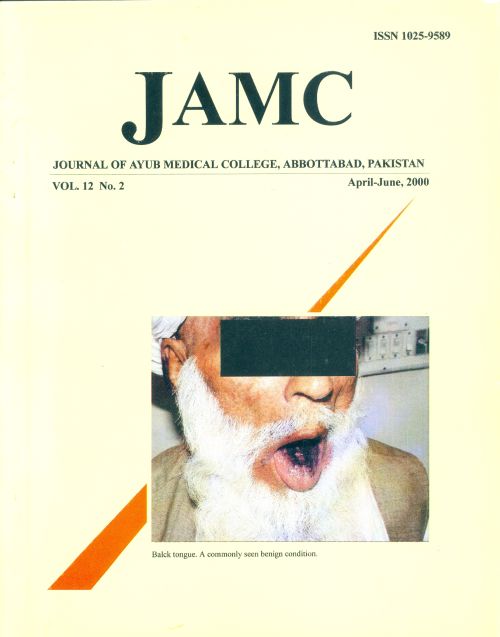GL YCOHEM OG LOB IN AND INCIDENCE OF CORONARY HEART DISEASE
Abstract
Background: Presence of glucose on Hb1-c is established and represents a post translational glycosylation by a slownon-enzymatic process occurring during the 120 days' life span of RBCs. It is an indicator of long term glycemic
control. Glycohemoglobin is directly related to blood glucose level. Methods: 50 randomly selected diabetic patients
were included and divided into two groups B and C of 25 subjects each. The subjects of group C were the diabetics
who were confirmed cases of CHD. while group B were the diabetics without any complications. Group A consisted
of healthy controls (n=25). Glycohemoglobin was determined by column chromatography while blood glucose was
estimated by enzymatic method. Results: Blood glucose was increased in both the patient groups (p<0.001).
Comparison of HbA| revealed a highly significant rise (p<0.001) in both the groups against normal control subjects
of group A. Correlation of Hb1-c with glucose in all the three groups was directly positive (r=+0.4). Conclusions: The
results of the present study suggest an association between HbA1-c hyperglycemia and the incidence of CHD in
diabetics.
References
Kennedy. L. and Lyons, T.J. (1989). Non enzymatic
glycosylation, Br. Med. Bull 45(9): 174-90.
Dunn, L, F. (1982). Hyperlipidemia and diabetes Med. Clin.
N. Am, 66(6): 1347.
Kenneth, H., Gabbay, K.H. Jan, 1... Breslow R. Curtis, E.H.,
Franklin, B. and Paul, M.G. (1977). Glycosylated
hemoglobin's and long term blood glucose control in
diabetes mellitus. .1. tin Endocrinol Metah. 144(5): 859-64.
Mceance, D.R Hanson, R.L., Charles, M.A., Jacobson. L.T.H.
Pewttit. D. Benett. P.H. and Knowler. W.C (1994).
Comparison of tests for glycated hemoglobin and fasting and
two hours plasma glucose concentrations as diagnostic
methods for diabetes. B.M. J. 1323-8.
Gabhay. K. H. (1982). Glycosylated hemoglobin and diabetes
mellitus. symposium on diabetes mellitus. Med Clin. N. Am.
(6): 1301-
Kayaba, K., Nago, N., Miyamoto, T. and Mizooka, .VI.
(1989). Glycated hemoglobin levels and their correlation with
atherosclerotic risk factors in a Japanese population the Jichi
medical school Cohort study 1993-95. Jpn-Cir- J;62(4):261 -
Steffes, M.W. (1997). Glycemic control and the initiation and
progression of the complications of diabetes mellitus. KidneyInt- Suppl.63:936-9
Rehnian, J. and Rehman. VI. A. (1991). Studies on
glycosylated plasma proteins in diabetic patients J. Pak. Vied.
Assoc. 41(1): 15-8
Pickup, J.C., Mattock, VI.B.. Crook. M.A.. Chusney. G.D.,
Burt D. and Fitzgerald, A.P. (1995). Serum sialic acid
concentration and coronary artery disease in
NIDDVl. Diabetes care: 18(8): 11003-3.
Koeing, R.J., Peterson, C.M., Jones, R;L., Ssaudek, C.,
Lehrman, VI. and Carami. A. (1976). Correlation of glucose
regulation and hemoglobin Al-c in diabetes mellitus. N,
Engl. J. Med. 295:417-20
Jain, S.K., Movie, R., Jaramillo, J.J. and Chen. Y. (1998)
Hyperketonemia (aceto acetate) increase the oxidizability of
LDL & vldl IN TYPE-1 DIABETIC PATIENTS. Free
Radie-Biol-Me;24(l): 175-81.
Martinez, O.M.A., Heranz, M.L., Martin, V.P., Macro, M.A.,
Grande, C., Alvero, Fetal. (1997). The metabolic control of
insulin-dependent diabetes mellitus and diabetic nephropathy.
(Abstract). Lin-Esp. 197(1): 18-22
How to Cite
Issue
Section
License
Journal of Ayub Medical College, Abbottabad is an OPEN ACCESS JOURNAL which means that all content is FREELY available without charge to all users whether registered with the journal or not. The work published by J Ayub Med Coll Abbottabad is licensed and distributed under the creative commons License CC BY ND Attribution-NoDerivs. Material printed in this journal is OPEN to access, and are FREE for use in academic and research work with proper citation. J Ayub Med Coll Abbottabad accepts only original material for publication with the understanding that except for abstracts, no part of the data has been published or will be submitted for publication elsewhere before appearing in J Ayub Med Coll Abbottabad. The Editorial Board of J Ayub Med Coll Abbottabad makes every effort to ensure the accuracy and authenticity of material printed in J Ayub Med Coll Abbottabad. However, conclusions and statements expressed are views of the authors and do not reflect the opinion/policy of J Ayub Med Coll Abbottabad or the Editorial Board.
USERS are allowed to read, download, copy, distribute, print, search, or link to the full texts of the articles, or use them for any other lawful purpose, without asking prior permission from the publisher or the author. This is in accordance with the BOAI definition of open access.
AUTHORS retain the rights of free downloading/unlimited e-print of full text and sharing/disseminating the article without any restriction, by any means including twitter, scholarly collaboration networks such as ResearchGate, Academia.eu, and social media sites such as Twitter, LinkedIn, Google Scholar and any other professional or academic networking site.










